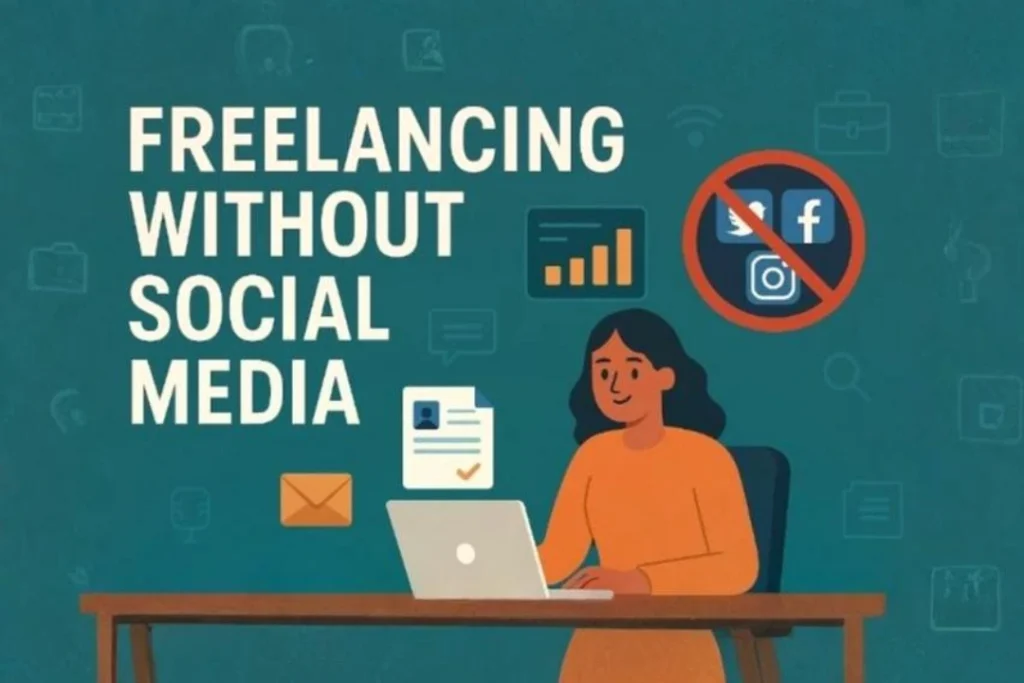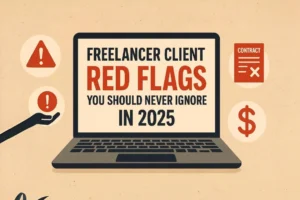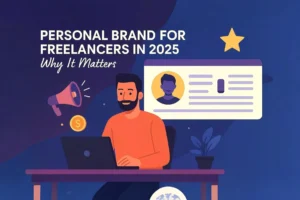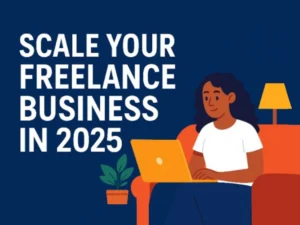Introduction: Why This Topic Matters in 2025
Freelancing without social media will not be a reality in 2025, but it is a possibility more than ever. Even though the majority of freelancers still rely on websites like LinkedIn, Instagram, or X to promote themselves, more and more freelancers are finding success in different ways. Whether you’ve ever grown tired of constant posting, algorithm changes, or the requirement to build a personal brand online, you’re not alone. Freelancing without the involvement of social media could be a practical and workable path to career progression.
Nowadays, clients are still looking for good freelancers — they’re just not always necessarily going to look for them on social media. With a solid portfolio, good communication, and focused outreach, you can find good clients without having to go viral or chase likes. Freelancers are discovering that by spending their time and energy elsewhere, they’re getting higher-quality clients with less stress.
This article will explore how to succeed without social platforms, offer real-world tips, and show you tools that replace what social media used to offer. Whether you’re new to freelancing or looking to escape the social media grind, you’ll find proven strategies to help you stand out, get hired, and build a thriving freelance business — completely off the feed.
The Rise of Social Media-Free Freelancers
The past couple of years have witnessed the idea of freelancing without social media shift from the periphery to the mainstream. More and more freelancers are leaving behind Instagram, TikTok, and even LinkedIn—not because they’re not pro-technology, but because they’ve found smarter methods to locate clients and establish their careers. In 2025, it’s no longer a novelty to meet a successful freelancer who doesn’t go online daily, yet does well and has best-of-the-best clients.
This shift is being initiated by several reasons. Algorithms refresh continuously, engagement declines, and burnout occurs. Meanwhile, freelancers are discovering that they can build a successful client base through portfolios, referrals, freelancer sites, and even cold email prospecting. In fact, one of the most effective means of scaling is by building a strong foundation in the first place. If you’re just starting out in freelancing, check out this realistic guide to starting freelancing in 2025 — it spells out the essentials of getting your first gigs without having to rely on social followers.
The bottom line? You don’t need to chase likes and comments to build a successful freelance career. Many freelancers are demonstrating that by focusing on real skills, strategic networking, and delivering value, it’s perfectly possible to grow without spending a single minute creating social site content. Freelancing apart from social sites is no longer the exception — it’s a rising trend that’s here to stay.
Do You Need Social Media to Get Clients?
One of the biggest assumptions of today’s digital age is that success requires you to be online. But does it necessarily have to when you’re freelancing without social media? The short answer is no — a lot of freelancers find clients outside of sharing content and having an audience on Instagram, LinkedIn, or X.
Social media is effective, but it’s not the greatest — or even the only — means to get stable freelance work. Some of the most successful freelancers utilize platforms like job boards, cold pitches, referrals, or freelance platforms. These methods have you focused on client work instead of chasing likes or engagement.
For instance, if you’re just starting out as a freelancer and need to land more lucrative work, building your presence on trusted platforms and learning to communicate value matters more than building a following. Check out our guide to how to get high-paying freelance clients in 2025— it’s packed with tips that don’t rely on any social media presence.
Why Some Freelancers Quit Social Media (And Thrive)
Contrary to what is said, most freelancers are thriving by being full-time freelance without social media. They’re not just surviving but earning stable income streams, building loyal client bases, and experiencing better work-life balance without the pressure of posting, engaging, or building personal online identities.
There are several reasons freelancers walk away from social platforms. For some, it’s the time sink. Others find that constantly comparing themselves to others harms their confidence and productivity. Instead, they double down on relationship-building, referrals, and email outreach — all of which can be far more effective in winning long-term contracts.
In fact, focusing your energy on improving client experience and scaling your services may offer a more sustainable path forward. Learn how to expand your income and attract quality clients without relying on social media in our detailed guide: Scale Your Freelance Business in 2025.
Proven Ways to Succeed Without Social Platforms
If you’re determined to freelance without social media, you’ll need to be strategic about getting visible and acquiring clients. The good news is that plenty of freelancers are already thriving without posting every day and chasing likes. What you’ll find below are six battle-tested strategies that will get you visible and booked solid in 2025 without the use of any social media platforms.
1. Develop a High-Converting Portfolio Website
Your online professional anchor is your website. Who you are, what you do, and who you help should be very apparent there. Showcase your best work, client success stories, and case studies where relevant. Don’t neglect calls to action on every page and a simple way for potential clients to contact you. If you need help getting one set up, our article on building a personal brand covers this step by step.
2. Utilize Freelance Marketplaces Strategically
Websites like Upwork, Freelancer, PeoplePerHour, and Fiverr offer direct access to paying clients. Instead of bidding for every job, focus on niches where you excel. Develop custom proposals that solve real problems, and once you’ve landed your first few projects, make exceeding expectations your priority. That early momentum goes a long way in enhancing your visibility on these sites and converts to repeat business.
3. Harness Referral and Word-of-Mouth Power
There is no introduction better than a warm one from a happy client. Make referrals part of your project wrap-up. You can even offer a discount or gift for every referral that results in a new contract. As you get more positive testimonials, feature them on your website and proposals to build instant credibility with new prospects.
4. Harness Cold Outreach (Without Being Spammy)
Cold outreach still works if it’s considerate and targeted. Start by scouting for prospective clients in your niche. Look at company websites, job postings, or LinkedIn profiles. Craft personalized emails that briefly explain who you are, what you can do for them, and why it matters. Keep it brief, polite, and value-driven. Follow up politely after a few days — persistence without pressure is the key.
5. Join Online Communities and Forums
Freelancers often underestimate the value of niche forums and discussion boards. Join spaces like r/freelance on Reddit, Indie Hackers, or relevant Slack groups. Don’t just lurk — actively participate, answer questions, and offer insights. Over time, people begin to recognize your expertise and may reach out for paid work, partnerships, or referrals.
6. Optimize for SEO and Let Clients Find You
One of the strongest ways of freelancing without social media is having a solid Google presence. Start a blog on your website and write content that specifically solves your ideal client’s problems. Use keywords, use internal linking to your services, and make your content scannable. Over time, your content can drive consistent traffic and client leads without you posting online at all.
Pros and Cons: Social Media vs. No Social Media
All freelancers eventually reach the point of deciding if and how to rely on social media. Although freelancing without it means less distraction and more independence, there are compromises. Let’s go through the pros and cons of each so you can determine what is best for your workflow and goals in 2025.
Freelancing With Social Media
The Pros
- Free marketing tools: Platforms like LinkedIn, Instagram, and X (formerly Twitter) let you promote your work without spending money on ads.
- Community engagement: You can connect with other freelancers, industry experts, and potential clients quickly.
- Trend visibility: Social platforms make it easy to stay current with client demands, niche trends, and competitor strategies.
The Cons
- Time drain: Posting, commenting, and engaging takes significant time that could be spent on billable work.
- Algorithm dependence: Your visibility depends on ever-changing rules that you cannot control.
- Burnout risk: Constant self-promotion and comparison can lead to creative exhaustion or even anxiety.
Freelancing Without Social Media
The Pros
- Focus and deep work: Without social distractions, you can deliver better results for clients and stay in your zone of genius.
- More privacy and control: You choose what to share and where, and you’re not forced to document every achievement online.
- Long-term strategies: Tactics like SEO, referrals, and marketplaces provide more stable client pipelines over time.
The Cons
- Slower start: Without a built-in audience, gaining visibility may take longer, especially if you’re new to freelancing.
- Less passive reach: You’ll need to be more proactive in outreach and rely on platforms like your website, email, or freelance sites.
- Fewer networking opportunities: Some collaborations and client leads do originate from social circles, which you might miss out on.
Finally, both approaches can work. What you have to do is choose the one that best works for your personality, strengths, and business goals. You can even do a combination at different stages in your career. But if you are predisposed towards freelancing without social media, you can be certain that this is a sustainable and viable option, provided you add smart outreach and SEO to it.
When Should You Consider Skipping Social Media?
If you’ve ever felt tired trying to keep up with social platforms, it might be time to think about freelancing without social media. Not all freelancers do well in a world where there is always posting, scrolling, and chasing algorithms. A lot of successful freelancers actually find more freedom and consistency by not using the platform at all and building their business through other means.
If social media makes you more stressed than it helps, you should really think about not using it. If you’re spending hours making content and still can’t get clients, you might want to spend that time improving your personal brand, building your portfolio, or optimizing your outreach strategy. In fact, your personal brand as a freelancer can grow faster through your website, niche platforms, and word of mouth than through a busy feed.
Yet another good reason to be social-free is if you perform best under structure and having long-term plans. Instead of seeking out viral posts, you could focus on tried and tested methods like SEO, email marketing, or freelance marketplaces. If you have already experimented with platforms and concluded that they clash with your personality or working style, being social-free can open up more intense and fruitful avenues. Just remember that freelancing without social media is not hiding, but it’s choosing how and where you want to be seen.
Tools That Replace Social Media Marketing for Freelancers
One of the biggest myths of freelancing from social media is that you’ll never be able to market yourself. That is absolutely not true. In 2025, there are smarter, more focused tools that help you get seen, generate leads, and own your brand without algorithms or having to constantly post.
Email marketing tools like ConvertKit or Mailerlite allow you to build a list of prospective customers and keep them engaged with valuable insights. By selecting the right sequence and lead magnet, you are able to build client relations in a passive manner while still able to focus on work that pays.
Portfolio presentation sites such as Behance, Dribbble, or even a nicely built Notion portfolio give visual real estate to present your work. Organic traffic flows in from these sources and lets your skills talk for themselves without your needing to turn to social media engagement.
Freelancers also must consider CRM software such as Bonsai that assist them in processing contracts, proposals, and invoices. Such systems keep your business running smoothly and make you appear professional to potential new clients.
Finally, you must be aware of whom your time is worth. If you do not want to go through unnecessary headaches, read our blog post regarding freelancer client red flags in 2025 so that you can focus on clients who value your work.
Conclusion
Freelancing without social media is not only feasible in 2025, but it is becoming increasingly practical. Many freelancers are choosing other avenues that deliver better results without the worry of frequent posting and algorithm updates. If you prefer deep work or simply desire privacy, this approach can meet your goals and lifestyle better.
Instead of chasing likes, focus on mastering productivity and communication. For example, staying focused by eliminating common remote work distractions can instantly improve your efficiency. You can also enhance your service quality using AI tools for better client feedback, or grow your income passively with micro-investing apps built for freelancers.
If social media isn’t a part of your freelance business anymore, don’t force it. You can still create a thriving freelance business on your own terms and let your results speak for themselves, not your social stream, with the proper systems and tools in place.





